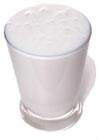 Churn buttermilk is the fluid remaining when the fat is removed by churning cream into butter. It was formerly drunk as a beverage, but today it is mostly condensed or dried for use in the baking and frozen desserts industry. Despite its name, it is not high in fat. Churn buttermilk is the watery end-product of butter making... but it has been replaced as a beverage by cultured butter milk.
Churn buttermilk is the fluid remaining when the fat is removed by churning cream into butter. It was formerly drunk as a beverage, but today it is mostly condensed or dried for use in the baking and frozen desserts industry. Despite its name, it is not high in fat. Churn buttermilk is the watery end-product of butter making... but it has been replaced as a beverage by cultured butter milk.
Before World War II much of the butter produced in the United States was made from gathered cream . Farmers separated milk on the farm and shipped cans of cream to a butter factory, sometimes once or twice a week. The cream was often sour and needed to be neutralized (with sodium hydroxide) before churning. When transportation and the value of the skim portion improved, whole milk was shipped to the creamery, providing a supply of “sweet cream” ( i.e., cream that had not soured) for butter making. With these improvements came the advent of higher-quality butter and the demise of naturally soured buttermilk.
Most modern buttermilk is cultured buttermilk, made from low-fat or skim milk and has less than 2 percent fat and sometimes none. It is prepared from skim or low-fat milk by fermentation with bacteria that produces lactic acid. The resulting product is thicker than traditional butter milk but is similar to it in other respects. Its correct name in many jurisdictions is “cultured low-fat milk” or “cultured nonfat milk.”
Cultured buttermilk, like skim milk, consists mainly of water (about 90 percent), the milk sugar lactose (about 5 percent), and the protein casein (about 3 percent). Butter milk made from low-fat milk contains small quantities (up to 2 percent) of butter fat. In both low-fat and nonfat butter milk, some of the lactose is converted by the bacteria into lactic acid , which gives the milk a slightly sour taste and makes it easier to digest by lactose-intolerant consumers. The high numbers of live bacteria organisms are also thought to provide other healthful and digestive benefits.
How is cultured buttermilk made?
The starting ingredient for buttermilk is skim or low-fat milk. The milk is pasteurized at 82° to 88° C (180° to 190° F) for 30 minutes, or at 90° C (195° F) for two to three minutes. This heating process is done to destroy all naturally occurring bacteria and to denature the protein in order to minimize wheying off (separation of liquid from solids).
The milk is then cooled to 22° C (72° F), and starter cultures of desirable bacteria, such as Streptococcus lactis, S. cremoris, Leuconostoc citrovorum , and L. dextranicum , are added to develop buttermilk's acidity and unique flavour. These organisms may be used singly or in combination to obtain the desired flavour.
The ripening process takes about 12 to 14 hours (overnight). At the correct stage of acid and flavour, the product is gently stirred to break the curd, and it is cooled to 7.2° C (45° F) in order to halt fermentation. It is then packaged and refrigerated.
Substitutes
- Combine one cup of milk (or soymilk) plus one tablespoon of lemon juice or vinegar, and allow to stand for ten minutes
- Combine one cup of milk plus two teaspoons cream of tartar, and allow to stand for ten minutes
- Combine two parts plain yogurt plus one part milk
- plain, low-fat yogurt
- sour cream
- molasses (in batters that also call for baking soda)
Note that churn buttermilk may require longer baking times than ordinary commercial buttermilk.
